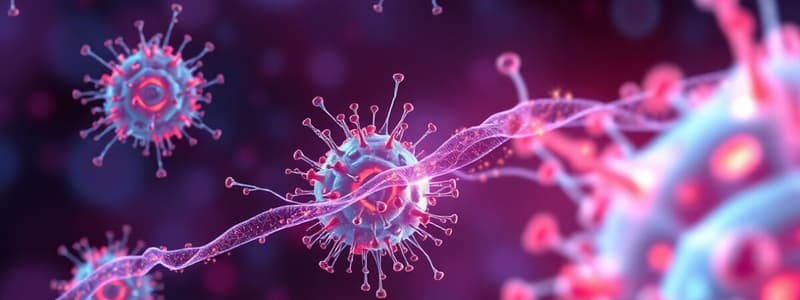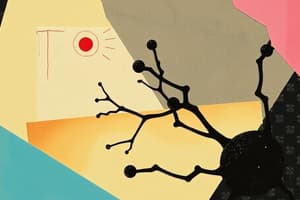Podcast
Questions and Answers
What is the primary function of cytotoxic T cells (CD8+ Tc)?
What is the primary function of cytotoxic T cells (CD8+ Tc)?
- Activate macrophages during inflammation
- Defend against parasitic infections
- Mediate B cell activation
- Induce cell death in infected cells (correct)
Which statement correctly describes T cell receptors (TCRs)?
Which statement correctly describes T cell receptors (TCRs)?
- They are soluble proteins found in serum
- They recognize antigens without the need for MHC
- They have a stronger binding affinity than antibodies
- They consist of two polypeptide chains, α:β or γ:δ (correct)
What is the role of CD3 proteins in T cells?
What is the role of CD3 proteins in T cells?
- Bind directly to antigens
- Act as co-receptors for MHC
- Facilitate antigen recognition
- Enhance signaling function of TCR (correct)
Which class of MHC proteins is found on all nucleated body cells?
Which class of MHC proteins is found on all nucleated body cells?
How do T cells distinguish between self and non-self peptides?
How do T cells distinguish between self and non-self peptides?
What is a key characteristic that differentiates T cell receptors from B cell receptors?
What is a key characteristic that differentiates T cell receptors from B cell receptors?
What is the mechanism that contributes to TCR diversity?
What is the mechanism that contributes to TCR diversity?
What role do CD4 and CD8 co-receptors play in T cell function?
What role do CD4 and CD8 co-receptors play in T cell function?
Flashcards
T Cell Receptor (TCR)
T Cell Receptor (TCR)
A protein complex found on the surface of T cells, responsible for recognizing and binding to specific antigens presented by MHC molecules.
TCR Chains
TCR Chains
Two polypeptide chains, alpha and beta, that make up the TCR.
TCR Antigen Binding Site
TCR Antigen Binding Site
A specialized region within the TCR that interacts with the MHC molecule.
CD3 proteins
CD3 proteins
Signup and view all the flashcards
Co-receptors (CD4 or CD8)
Co-receptors (CD4 or CD8)
Signup and view all the flashcards
CD4+ T cells
CD4+ T cells
Signup and view all the flashcards
CD8+ T cells
CD8+ T cells
Signup and view all the flashcards
TCR Ligand Recognition
TCR Ligand Recognition
Signup and view all the flashcards
Study Notes
T Cells and T Cell Receptors
- T cells are crucial for the adaptive immune system, specializing in cell-mediated immunity.
- T cells recognize specific peptide antigens presented by major histocompatibility complex (MHC) molecules.
- T cells come in different types, including cytotoxic T cells and helper T cells (e.g., TH1, TH2, TFH).
- Effector functions of T cells include inducing cell death, activating macrophages, mediating anti-parasitic responses, and B cell activation.
- T cell activity relies on interactions between T cell receptors (TCRs) on T cells and MHC-peptide complexes on target cells.
T Cell Receptor (TCR)
- TCR is a protein complex comprising TCR itself and associated proteins.
- TCR is formed by two polypeptide chains (e.g., alpha and beta).
- Associated CD3 proteins enhance signaling.
- Co-receptors (e.g., CD4 or CD8) are necessary for ligand recognition.
- T cells are divided into CD4+ and CD8+ subsets.
- ITAMs (Immunoreceptor Tyrosine-based activation motifs) are essential components of the TCR signaling pathway.
TCR vs. B Cell Receptor
- TCRs are solely membrane-bound.
- TCR antigen binding is weaker than antibody binding.
- Antigens recognized by T cells are presented by MHC molecules.
TCR Diversity
- TCR diversity is generated through combinatorial joining of V(D)J gene segments, junctional flexibility, P-region, and N-region nucleotide additions. These mechanisms mimic Ig (immunoglobulin) diversity.
- TCRs lack somatic mutations, which maintain their specificity after thymic selection, preventing self-reactive T cells.
T Cell Receptor Ligands
- MHC proteins present antigenic peptide fragments.
- MHC proteins are classified as MHC class I and II.
- MHC class I is found on all nucleated cells.
- MHC class II is found on antigen-presenting cells (APCs).
- CD8 co-receptors bind invariant parts of MHC class I.
- CD4 co-receptors bind invariant parts of MHC class II.
- T cells must distinguish between self and non-self peptides.
Alloreactivity
- Alloreactivity refers to the T cells' response to genetically different individuals (even of the same species).
- T cells typically respond to antigen presented by MHC molecules.
- However, T cells can recognize foreign MHC molecules, as seen in transplant rejection.
Studying That Suits You
Use AI to generate personalized quizzes and flashcards to suit your learning preferences.




